
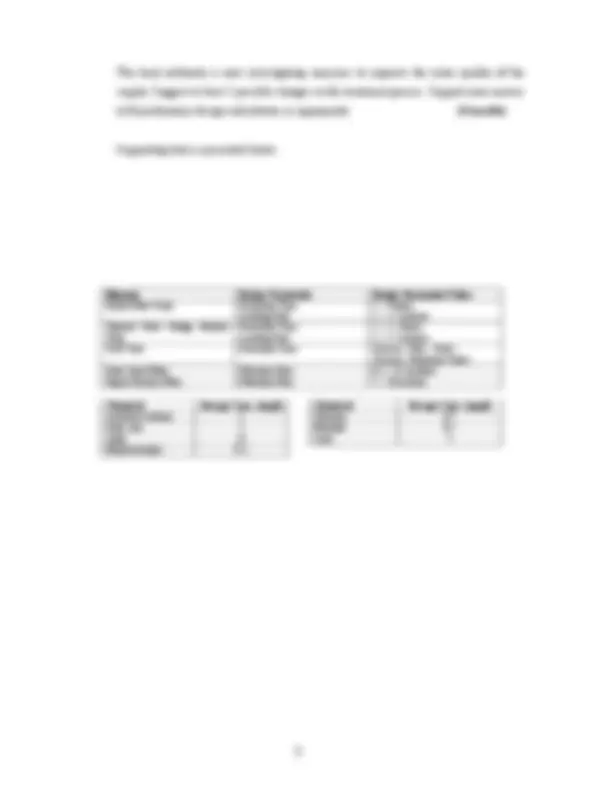
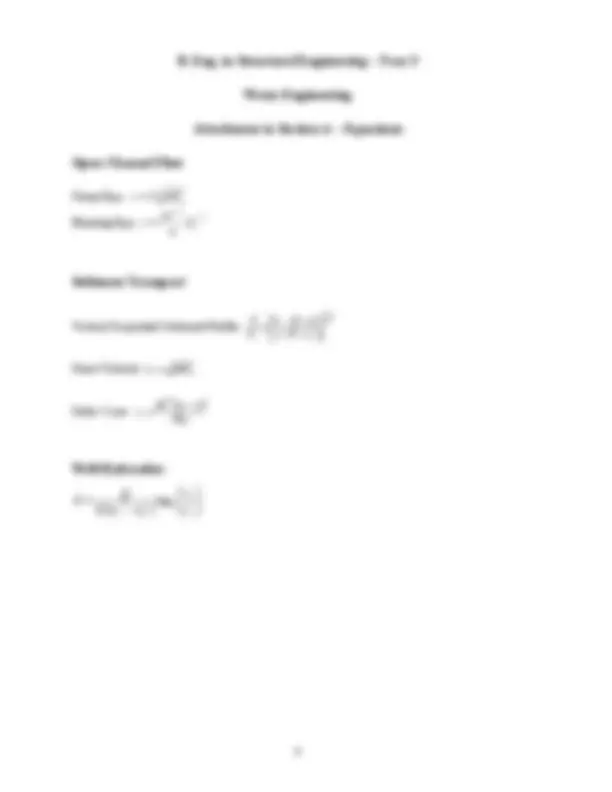
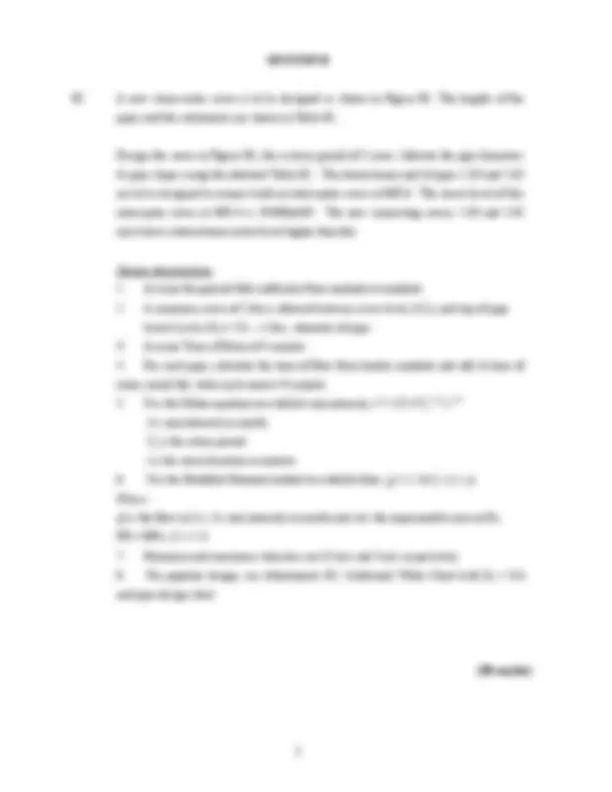
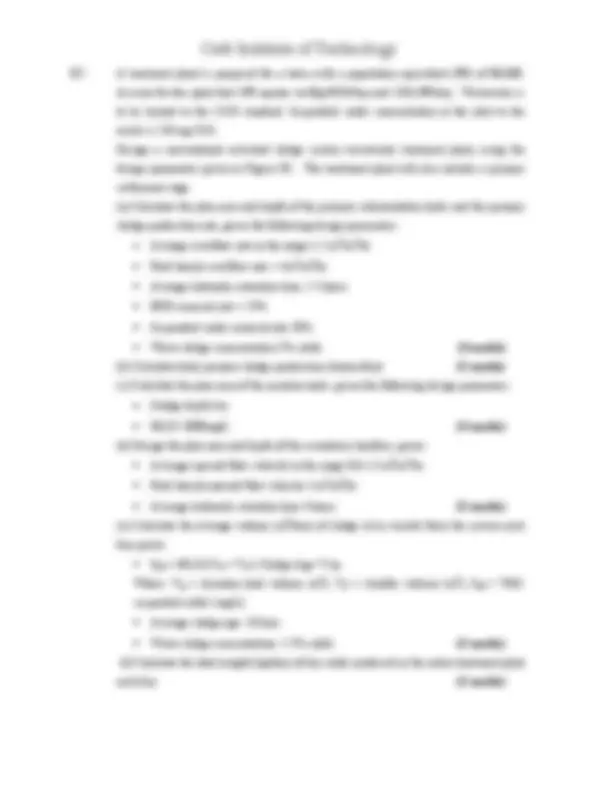
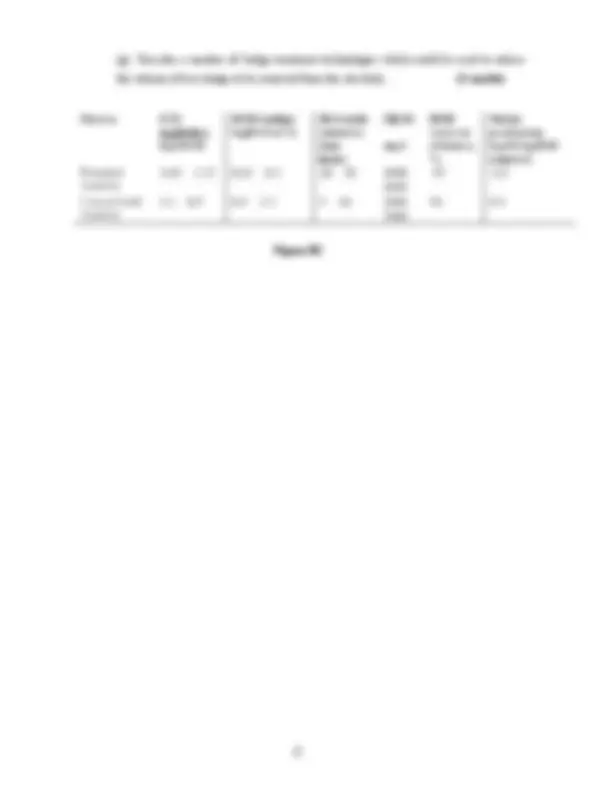
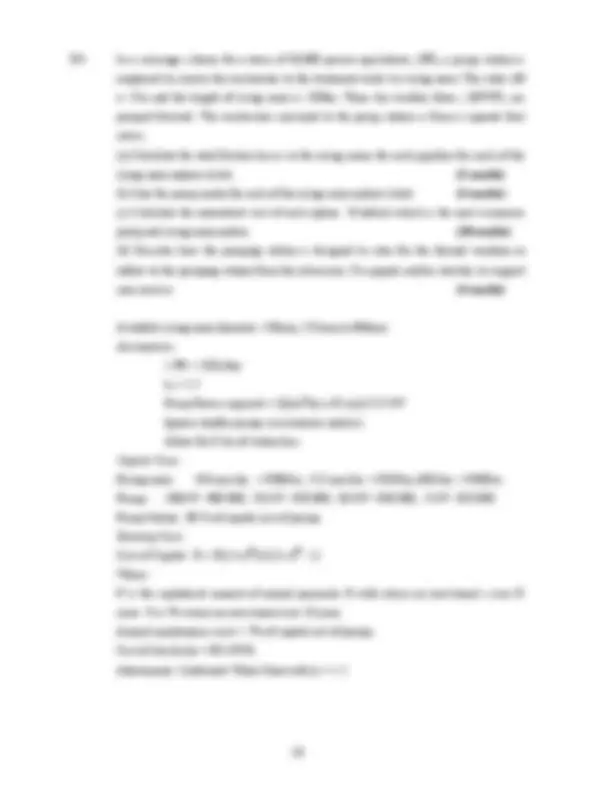
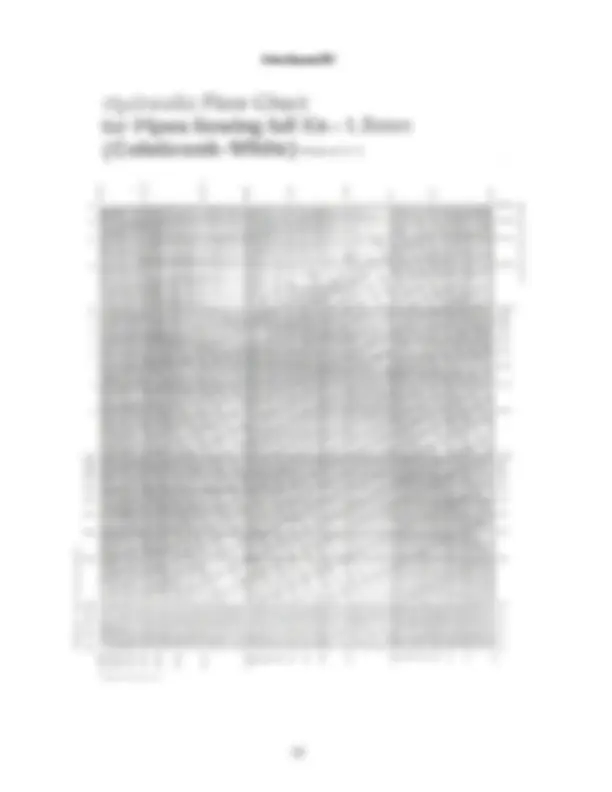


Study with the several resources on Docsity

Earn points by helping other students or get them with a premium plan


Prepare for your exams
Study with the several resources on Docsity

Earn points to download
Earn points by helping other students or get them with a premium plan
Community
Ask the community for help and clear up your study doubts
Discover the best universities in your country according to Docsity users
Free resources
Download our free guides on studying techniques, anxiety management strategies, and thesis advice from Docsity tutors
Main points of this past exam are: Flood Risk in Rivers, Flood Risk in Coastal Areas, Suspended Load, Bed Load, Threshold of Motion, Chezy Coefficient, Homogenous Concentration Distribution, Suspended Load Per Metre, Design Life Expectancy
Typology: Exams
1 / 13

This page cannot be seen from the preview
Don't miss anything!








Instructions Answer five questions in total, a minimum of Two questions from each section. Use separate answer books for each section. All questions carry equal marks. Programmable calculators are not permitted.
Examiners: Dr. J Harrington Mr. L O’Driscoll Prof. P. O’Donoghue Mr P. Anthony
Note: Attachments including equations 1(a) A water channel is V-shaped with each side making an angle of 45 degrees to the vertical. Calculate the volume of water passing per second when the depth of water in the channel is 0.5 m and the slope of the channel is 1 in 250. Take the Chezy Coefficient C as
(c) Salt is used in a freshwater environment to determine the river flow rate using dilution gauging. The salt injection rate is 1 litre/sec at a concentration of 100 mg/l. The background salt concentration was measured as 1 mg/l. The steady state concentration downstream was measured as 5 mg/litre. Determine the river flow rate and also the % error in the river flow rate if the background concentration is ignored. (5 marks)
2(a) Briefly discuss: (i) Suspended Load and Bed Load (4 marks) (ii) Threshold of Motion (3 marks)
(b) A wide river with a flow depth of 3m, a mean velocity of 1 m/sec and a Chezy coefficient of 50 m1/2^ /sec contains sediments of density 2650kg/m^3. A sample of the suspended sediment load taken at mid depth shows a mean diameter of 0.02mm with a concentration of 200 mg/l. The viscosity of water may be taken as 1.13 x 10 -3^ N sec/m^2. Establish the suspended sediment profile as a function of depth (at 0.5m intervals) given a k value of 0.4. Plot these results. Also calculate the suspended load per metre width assuming a homogenous concentration distribution. (9 marks)
(c) If the river in (b) is 250m wide and discharges into a downstream reservoir of capacity 1.5 x 10^7 m^3 , find the design life expectancy of this reservoir assuming the sediment to have a porosity of 0.3. (4 marks)
3(a) Discuss the following: (i) EU Water Framework Directive (4 marks) (ii) The outbreak of Cryptosporidium in the Mullingar, Co. Westmeath Water Supply System in 2002 (6 marks)
(b) A 9.15 m thick layer of sandy soil overlies an impermeable rock. Ground water level is at a depth of 1.22 m below the top of the soil. Water was pumped out of the soil from a central well at a rate of 5680 kg/min and the drawdown of the water table was noted in two observation wells. These two wells were on a radial line from the centre of the main well at distances of 3.05 m and 30.5 m. During pumping the water level in the well nearest the pump was 4.57 m below ground level and in the furthest well was 2.13 m below ground level. Estimate the K value of the soil. Comment on the type of aquifer involved and the assumptions inherent in this analysis. (10 marks)
4(a) Discuss the use of ‘traditional’ sedimentation tanks, high rate clarifiers and Dissolved Air Flotation in water treatment, with the aid of diagrams. (8 marks)
(b) A water treatment plant built in Ireland in the 1970’s supplies a community with a population equivalent of 25,000 with water. It receives its supply from a nearby lake which now suffers eutrophication problems. Estimate the demand from the community. Outline the likely treatment process within the plant, size the main elements for the treatment process and quantify the daily amount of any chemicals used. (8 marks)
Chezy Eqn.: v = C mS 0
Manning Eqn.: 01 /^2
2 / 3 v = mn S
v r
r r
s Y y
Y y y
y C
C (^)
− = −
Shear Velocity: u (^) * = gmS 0
Stoke’s Law: 18 (^ ρμ ρ)
(^2) − vs = gd p
1 2 2 22 1
log ( ) r
r h h
e
B1 A new storm-water sewer is to be designed as shown in Figure B1. The lengths of the pipes and the catchments are shown in Table B1.
Design the sewer in Figure B1, for a return period of 5 years. Indicate the pipe diameters & pipe slopes using the attached Table B1. The downstream end of pipes 1.03 and 2. are to be designed to connect with an interceptor sewer at MH 6. The invert level of this interceptor sewer at MH 6 is 20.000mOD. The new connecting sewers 1.03 and 2. must have a downstream invert level higher than this.
Design Assumptions
(20 marks)
Table B1PipeNr
Pipelength(m)
Fall(m)
Slope(m/m)
Diamete
r (mm)
Velocit
y (m/s)
Timeof Entry(mins)
Timeof Flow(mins)
Timeof Conc(mins)
ImpArea(ha)
TotalImpArea(ha)
Rain(mm/hr)
Q (L/s)
Capacity(L/s)
Upstream IL
(mOD)
D/stream IL
(mOD)
75
60
55
60
80
B2 A treatment plant is proposed for a town with a population equivalent (PE) of 80,000. Assume for this plant that 1PE equates to 60g BOD/day and 220L/PE/day. Wastewater is to be treated to the 25/35 standard. Suspended solids concentration at the inlet to the works is 220 mg SS/L. Design a conventional activated sludge system wastewater treatment plant, using the design parameters given in Figure B2. The treatment plant will also include a primary settlement stage. (a) Calculate the plan area and depth of the primary sedimentation tanks and the primary sludge production rate, given the following design parameters:
B3 In a sewerage scheme for a town of 40,000 person equivalents, (PE), a pump station is employed to convey the wastewater to the treatment works by rising main. The static lift is 27m and the length of rising main is 2500m. Three dry weather flows, (3DWF), are pumped forward. The wastewater conveyed to the pump station is from a separate foul sewer. (a) Calculate the total friction losses in the rising mains for each pipeline for each of the rising main options listed. (2 marks) (b) Size the pump motor for each of the rising main options listed. (4 marks) (c) Calculate the annualised cost of each option. Establish which is the most economic pump and rising main option. (10 marks) (d) Describe how the pumping station is designed to cater for the diurnal variation in inflow to the pumping station from the urban area. Use graphs and/or sketches to support your answer. (4 marks)
Available rising main diameter: 450mm, 525mm or 600mm. Assumptions: 1 PE = 220L/day ks = 1. Pump Power required = {Q(m^3 /hr) x H (m)}/125 kW Ignore standby pumps in economic analysis. Allow for 0.5m of station loss. Capital Costs: Rising main: 450 mm dia. = €300/m; 525 mm dia. = €350/m; 600 dia. = €400/m Pumps: 100kW - €80 000; 50 kW - €50 000; 30 kW - €40 000; 5 kW - €10 000. Pump Station: 80 % of capital cost of pumps Running Costs: Cost of Capital: R = P{(1+r) Nr}/{(1+r) N^ - 1} Where: P is the capitalised amount of annual payments R with return on investment r over N years. Use 5% return on investment over 10 years Annual maintenance costs = 7% of capital cost of pumps. Cost of electricity = €0.1/kWh Attachments: Colebrook White Chart with ks = 1.
B4(a) Discuss the following rainfall relationships, and how they impact upon any hydrological analysis of a rural catchment: (i) Intensity-duration-frequency (ii) Depth-Area-Duration (6 marks)
B4(b) Describe the primary factors that influence the overall water-balance in a predominantly rural catchment. Explain how changes to these factors can influence the river hydrograph at the downstream end of the catchment. (8 marks)
B4(c) Describe how the infiltration capacity of the soil can influence the runoff from a greenfield catchment. (^) (3 marks)
Describe how the Dunne and Horton runoff mechanisms explain surface runoff. (3 marks)